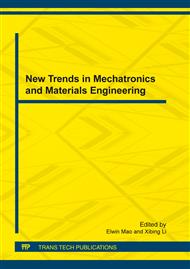p.690
p.695
p.700
p.703
p.707
p.711
p.716
p.721
p.726
Groove Optimization and Finite Element Analysis for Different Groove Milling Insert
Abstract:
Based on the experiments on milling the 45 steel with several types of different grooves milling inserts, this article has groove optimization and finite element analysis for different groove milling inserts. With the milling force testing system and orthogonal experimental design method, we have experiments with five types of different groove milling inserts for machining the 45 steel and compare their cutting capability, and the different grooves milling inserts are optimized. Based on the experiments, we have stress field analysis for different grooves milling inserts with finite element analysis method. The finite element analysis results are consistent with the experiment results well. All these studies provide the theoretic and experimental bases for groove development and groove optimization technology.
Info:
Periodical:
Pages:
716-720
Citation:
Online since:
January 2012
Authors:
Price:
Сopyright:
© 2012 Trans Tech Publications Ltd. All Rights Reserved
Share:
Citation:


